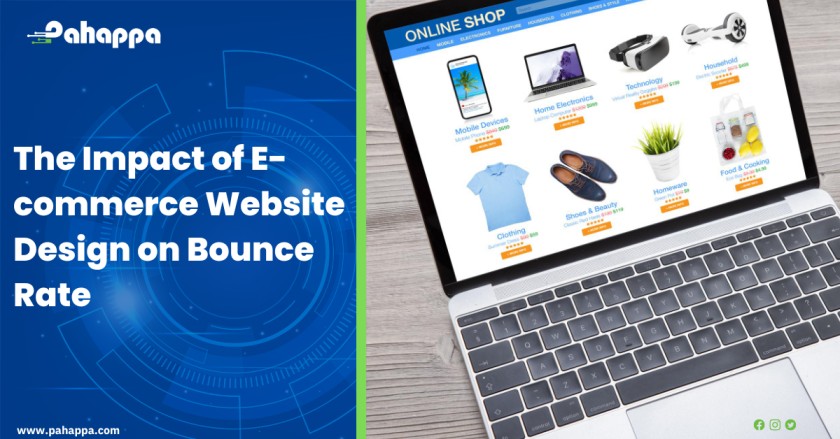When it comes to e-commerce websites, bounce rate is a critical metric that can directly impact the success of the business. Bounce rate refers to the percentage of visitors who leave a website after viewing only one page. A high bounce rate can be a sign that visitors are not finding what they are looking for or that the website design is not engaging enough to keep them interested. In this article, we will explore the impact of e-commerce website design on bounce rates and provide insights on how businesses can design their website to reduce bounce rates and increase conversions.
What is the Bounce Rate in E-commerce Website Design?
Bounce rate in e-commerce website design refers to the percentage of visitors who leave a website without interacting with any other pages or elements on the site. In other words, they “bounce” off the site after only viewing the initial page they landed on.
A high bounce rate can indicate that the website is not effectively engaging visitors or meeting their needs. It could be due to a variety of factors such as slow loading time, poor navigation, irrelevant content, or a lack of trust. While a low bounce rate can indicate that the website is successfully capturing and retaining the attention of visitors.
In e-commerce websites, a high bounce rate can have a significant impact on conversion rates and ultimately, sales. So, it’s important for e-commerce businesses to monitor their bounce rate and take steps to improve it if necessary. This can be done by optimizing page speed, enhancing user experience, creating targeted content, and building trust through social proof and customer reviews.
Ways in which E-commerce Website Design can impact Bounce Rate
Page speed
Page speed is an essential factor in keeping visitors engaged on an e-commerce website. Slow loading times can cause frustration and lead to visitors abandoning the site. E-commerce websites should optimize images, compress files, and reduce the number of HTTP requests to improve page speed. They can also use content delivery networks (CDNs) to store and deliver website content from servers closest to the visitor’s location, improving page load time.
Navigation
A clear and simple navigation menu is essential for an e-commerce website. Visitors should be able to find what they’re looking for quickly and easily. The navigation menu should be easy to understand and include search bars and filters to help visitors refine their search results.
Mobile-friendliness
With more consumers using mobile devices to browse and shop online, it’s essential for e-commerce websites to be optimized for mobile devices. Mobile optimization includes using a responsive design, optimizing images for mobile devices, and simplifying the checkout process for mobile users.
Content relevance
Visitors are more likely to engage with a website if the content is relevant to their needs and interests. E-commerce websites should create valuable and engaging content that speaks to their target audience. They can use customer data and analytics to personalize content and recommend products based on a visitor’s interests.
Trust signals
Trust signals such as customer reviews, security badges, and guarantees can help build trust with visitors and reduce the bounce rate. E-commerce websites should display customer reviews prominently, use security badges to indicate that the site is safe, and offer guarantees such as free returns to reassure visitors that they can shop with confidence.
Clear Call-to-Actions (CTAs)
CTAs are buttons or links that encourage visitors to take a specific action on the website, such as “Buy Now” or “Add to Cart.” CTAs should be placed in a prominent location on the page, such as above the fold, and should use clear and concise language that tells visitors what to do.
Visual appeal
A visually appealing website can help to create a positive first impression and encourage visitors to explore the site further. E-commerce websites should use high-quality images, easy-to-read fonts, and a clean and modern design. They can also use color psychology to create a mood or emotion that is in line with their brand identity.
Easy checkout process
The checkout process should be as simple and streamlined as possible, with a clear path to completing the purchase. E-commerce websites can simplify the checkout process by minimizing the number of steps required, using auto-fill to reduce the need for visitors to type in information, and providing a progress bar to show visitors how far along they are in the checkout process.
Relevant product recommendations
Product recommendations can help visitors discover products that they may be interested in and encourage them to make a purchase. E-commerce websites can use visitor data, such as purchase history and browsing behavior, to provide personalized product recommendations. They can also use social proof, such as displaying popular or trending products, to encourage visitors to explore the site further.
Accessibility
An accessible website is one that can be used by all visitors, regardless of any disabilities they may have. E-commerce websites should be designed to be accessible to all, with features such as alternative text for images, easy-to-use forms, and clear and concise language. Websites that are not accessible may have a higher bounce rate as visitors struggle to use the site.
E-commerce website design plays an important role in reducing bounce rates and increasing conversions. By investing in website development, businesses can create e-commerce websites that not only meet the needs of their users but also provide an enjoyable user experience that keeps them coming back. For professional website development services, Contact us today!











